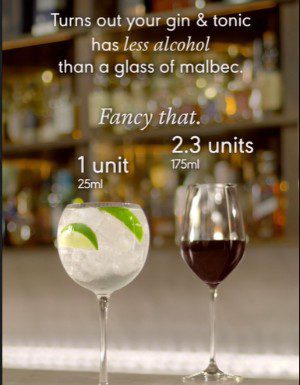Opinion: why Diageo is demystifying alcohol units
By Melita KielyJohnnie Walker owner Diageo has launched an educational campaign to help consumers understand alcohol units in popular drinks. Ian Smith, GB corporate relations director and chair of the UK Spirits Alliance, shares his opinion on the initiative.

Diageo has created the campaign, called Fancy That!, after learning there is a low consumer understanding of the difference between ABV (alcohol by volume) and units.
The company said the perceived ‘strength’ of a drink is often taken from the absolute ABV of a liquid, rather than the spirit when paired with a mixer.
Fancy That! will work to educate people that many mixed drinks with a single (25ml) spirit serve – a gin and tonic, for example – often have half the alcohol content compared with a pint of lager or a medium glass of wine.
The campaign launched across Stonegate pubs in the UK this week (27 October) and music streaming platform Spotify, and will run until the end of November.
From 3-30 November, the campaign will also appear on Stonegate’s MiXR app. Users can test their knowledge for the chance to win two tickets to Co-Op Live, the biggest entertainment arena in the UK, based in Manchester.
To mark the launch of the campaign, Diageo’s Smith has shared his views on the campaign and the wider discussion regarding ABV and units.
Ian Smith, GB corporate relations director and chair of the UK Spirits Alliance

“Three friends walk into a pub; one orders a pint of lager, one a medium glass of wine, and the third a gin and tonic. Sounds like the start of a bad joke, right?
“Yet with so many myths about the real strength of popular drinks, trying to manage your alcohol intake can be no laughing matter. At the heart is an outdated and misguided idea that distilled spirits, such as whisky, gin, and vodka, are so-called ‘hard liquor’ compared to beer and wine, and are somehow less appropriate for moderation.
“The fact is, spirits can play a powerful role in this growing trend for moderation. Their versatility and mixability make them perfectly placed to be drinks of moderation when enjoyed responsibly and in good company.
“Over the festive period, DRINKiQ is running a campaign across Stonegate pubs and Spotify that will challenge these misconceptions. The campaign will aim to educate drinkers about the number of units in popular spirits and mixer drinks, lager, and wine. By improving the understanding of units, we hope people across the country will gain the confidence of choice, empowering them to truly enjoy what they fancy, even when choosing to moderate.
“But how can gin, which by law has a minimum ABV of at least 37.5%, be just as powerful a moderation choice as a standard beer (5% ABV) and wine (13% ABV)? The answer lies in the true measure of alcohol consumption, alcohol units, which tell us the actual amount of alcohol in any given drink.
“If we return to our three friends at the bar, we will find:
- The lager drinker with their 5% ABV pint has just over two units of alcohol,
- The wine drinker, choosing a medium 13% ABV 175ml glass, will also have just over two units,
- The spirits drinker, with a single 25ml measure of 37.5% ABV gin and tonic or 40% ABV whisky and lemonade, is sipping just one unit of alcohol.
“Fancy that! There is no mystery or magic here; one unit of alcohol equals 10ml or 8g of pure alcohol, and the total number of units in a drink depends on both the size of the serve as well as the alcohol strength of the base liquid. In the case of mixed drinks like a gin and tonic, apart from the connoisseur who slowly sips a dram of their favourite whisky for example, the spirit measure is invariably diluted by the mixer, reducing the overall alcohol content.
“Alcohol units were first introduced in the UK in 1987 to help people track their alcohol consumption. Yet nearly four decades later, understanding of units remains woefully low, even amongst policymakers. Over the past two years, the Treasury’s excise duty system has chosen to tax spirits more than beer and wine, perversely rewarding drinks with higher units per serve.
“In the age of mindful drinking, there has never been a better time to understand alcohol units, and use this to make more informed choices at the bar. So, the next time you are in your local, tell your friends the one about the lager, the wine and the gin and tonic.”
Related news
Union agrees deal with Diageo over Crown Royal closure
